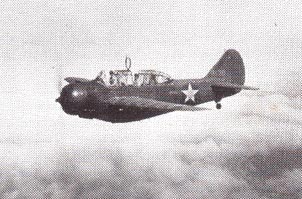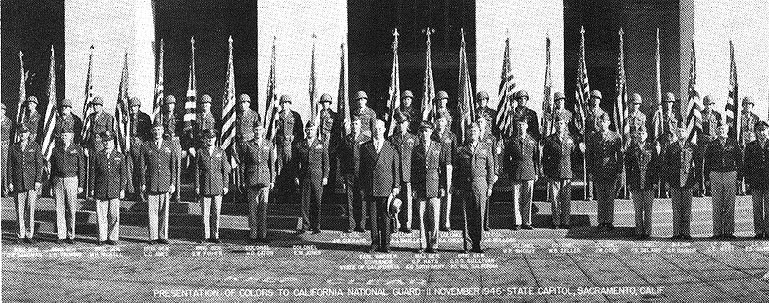About 12,000 troops of the California National Guard were called to federal duty in 1940 and 1941. Most
 served in
the Pacific area, but a large number of units served in the European
and Mediterranean theaters of operations. Upon the outbreak of
hostilities, the 40th
Infantry Division patrolled the California coast. Shortly
afterwards, the division went to Hawaii, assuming the defense
of the outer Hawaiian Islands. It was later deployed at Guadalcanal
and by January 1944, saw action on New Britain. The combat service
of the 40th includes; Bismarck Archipelago Campaign, The Lingayen
Gulf and Southern Philippines Campaign; assault Landings on Luzon
and Panay were conducted. The division cleared the Negros Islands
in April 1944 and was then sent to Korea where occupation duty
was performed from September 1945 to March 1946. The 250th Coast Artillery Regiment moved to Alaska
serving until the spring of 1944 when it returned to Fort Lewis,
Washington where units were redesignated and transferred. These
units and other California National Guard Artillery organizations
served either in the Pacific or the European theaters of operations.
served in
the Pacific area, but a large number of units served in the European
and Mediterranean theaters of operations. Upon the outbreak of
hostilities, the 40th
Infantry Division patrolled the California coast. Shortly
afterwards, the division went to Hawaii, assuming the defense
of the outer Hawaiian Islands. It was later deployed at Guadalcanal
and by January 1944, saw action on New Britain. The combat service
of the 40th includes; Bismarck Archipelago Campaign, The Lingayen
Gulf and Southern Philippines Campaign; assault Landings on Luzon
and Panay were conducted. The division cleared the Negros Islands
in April 1944 and was then sent to Korea where occupation duty
was performed from September 1945 to March 1946. The 250th Coast Artillery Regiment moved to Alaska
serving until the spring of 1944 when it returned to Fort Lewis,
Washington where units were redesignated and transferred. These
units and other California National Guard Artillery organizations
served either in the Pacific or the European theaters of operations.
The 40th Tank Company (later Company C, 194th Tank Battalion) of Salinas was the first of the California National Guard units to see action. They were sent to the Philippines in September 1940. When the war broke out, the company fought on Luzon; it was the last U.S. element to pull back to the Bataan Peninsula. When American and Filipino forces surrendered they were forced to participate in the infamous "Bataan Death March." Three Presidential unit citations were awarded to the 40th Tank Company for outstanding performance in combat operations.
On December 7, 1941 when the Japanese bombed Pearl Harbor, the 184th Infantry Regiment immediately left by convoy to their designated areas which were the Mexican border, San Diego to San Clemente coast. During the next several months, the regiment performed various types of duties such as Coast Patrols, Security Guards for the Army Air Force bases, railroad bridges and tunnels and major dams. During this period, the 184th Infantry Regiment was detached from the 40th Infantry Division in Fort Lewis and was attached to the 7th Infantry Division for amphibian training at Fort Ord.
When the 7th Division landed on Attu, the 184th Infantry remained in Fort Ord to form the 9th Amphibian Force (special task force) commanded by Col. Curtis D. O'Sullivan and later landed on the island of Kiska in the Aleutians. After Kiska, the 184th Infantry Regiment became part of the 7th Division and convoyed from the Aleutians to Hawaii for jungle and amphibian training. On August 16, 1943, after an artillery preparation, the 184th Regimental Combat Team (less 1st Battalion) with the 1st Battalion, 87th Mountain Infantry, field artillery, antiaircraft artillery and engineers attached, and with a Canadian Brigade on its right, prepared to land at Long Beach, Kiska. The commanding Officer of the 184th Infantry ordered the band to play the troops ashore. They responded with: "California, Here I Come," and "The Maple Leaf Forever." Once ashore, the troops patrolled in vain for the enemy. They found tables set for mess, blankets soaked in oil but not burned, and arms in good condition. Mines and booby traps were abundant and took their toll - but not in the 184th.
When the Nation was celebrating VE Day in Europe, the 184th Infantry was slamming through the NAHA- HURI-YANABAROU line, ending the stalemate that had tied up four divisions. Once again, the 184th lived up to its regimental slogan: "LET'S GO." After breaking through the Yanabarou line, units of the 184th Infantry Regiment captured Chinen Peninsula.
After VJ Day, on September 5,1945, the 7th Division set sail for Korea to disarm and repatriate the Japanese prisoners of war. The 184th Infantry area of responsibility was the city of Seoul and the areas along the Han River.
Colonel Roy Green, then the 184th Infantry commander, accepted the Japanese surrender at Seoul, Korea. The 184th left Federal service in January 1946. The unit officially rejoined the rolls of the California National Guard November 11th of that year.

Facta Non Verba
(Deeds, Not Words)
Luzon
Southern Philippines
Headquarters Battery, 204th Field Artillery Group:
Rhineland
Ardennes-Alsace
Central Europe
Contendimus
(We Strive)
Northern France
Rhineland
Ardnennes-Alsace
Central Europe
980th Field Artillery Battalion: Sondershousen, Germany
981st Field Artillery Battalion: Bad Frankenhousen, Germany
Rien Apas Beau
(Nothing Is In Vain)
August 1945 Location: Mulchen Gladbeck, Germany
Po Valley
August 1945 Location: Rosa, Italy
August 1945 Location: Camp Gruber, Oklahoma
We Aim to Hit
Northern Solomons
Leyte
Southern Philippines
Northern Solomons
Luzon
August 1945 Location: Manila, Commonwealth of the Philippines
Unity for Service
Northern France
Habeant
(Strike)
Luzon
Southern Philippines
Let's Go!
Eastern Mandates
Leyte
Ryukyus
Nunquom Non Paratus
(Never Unprepared)
Luzon
Southern Philippines
Luzon
Southern Philippines
 The Fighting Fortieth in War and Peace
The Fighting Fortieth in War and Peace